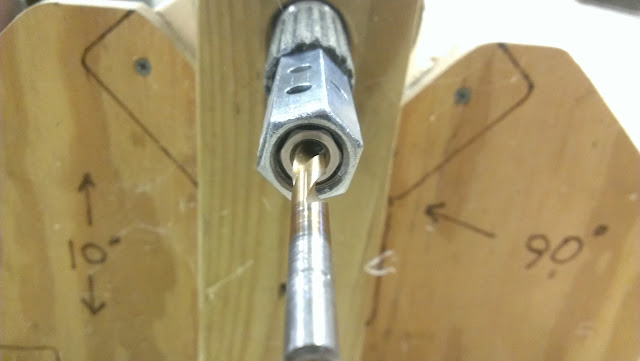I previously made a battery dispenser for the house (you can buy a commercial holder, but I wanted a dispenser). This first model was a trial and error wood design and had to be mounted a couple inches from the wall.
 |
| I used #4 machine screws and ballpoint pen springs as 'plungers'. |
It works well, but I wanted a flush mount for the boat and if I could make it lighter and moisture-proof that would be nice too, so I bought some Expanded PVC sheets - 1/8" and 1/2" to experiment with.
I love this stuff - it's a great boat material - easy to cut and shape. It's waterproof and unlike Starboard it can be easily glued to not only itself, but to wood. I did some tests and was impressed with, Gorilla Glue, All Purpose Cement (Oatey 30821) and epoxy. Silicone worked, but as to be expected, I wasn't impressed with the holding.
 |
| The 5200 takes so long to cure I gave up on it. |
 | ||
| This was a test model to see how things might go and what sizes would work. |
With the wood version, I cut relief slots in the backing plate to slide the dividers into for gluing. I also made spacers to keep the dividers vertical while the epoxy set up. This time I would use the spacers with All Purpose Cement and stick the dividers directly to the surface of the Expanded PVC back plate.
 |
| The wood spacers were cut away at the lower edges to keep oozing glue from sticking to the spacers. |
 | |
| I glued four vertical guides to the backing plate so it would be easy to position the divider group on the plate after glue was applied to the 1/8" divider edges using a syringe. |
I mechanically fastened the 'puller' base and the sides (w/ stainless sheet metal screws) so if things didn't work out I wouldn't have to un-glue anything, but so far except for the slightly larger areas between the dividers, everything is working better than expected.
 |
| The little handle at the top of the unit allows the plexiglass front to be raised to 'refill' the dispenser. |
 |
| On the wood version, I shimmed out from the base so each column of batteries would be close to the plexiglass. On this version I'll see if that is necessary before going to the trouble. |
And unlike the home version where any battery can always be dispensed, the marine version will have a lower plexiglass position that will keep the batteries captive while the trailered boat is being jostled on the road or in enthusiastic sea conditions.
I still haven't decided what to do with the exposed rods...maybe a small knob on each or I could bend them down 90°? We'll see.
~Addendum~
Over 20" of "D" cells falling after one is removed is quite a strain on the dispenser. Also, I realized that on the boat I don't have the luxury of a lot of room to slide the plexiglass up to refill the dispenser. Even after cutting the boat unit down to about 11" I still didn't have room anywhere on the boat to slide up the plexiglass to reload the dispenser.
I bent the pull rods down 90° to see if I could slide the plexiglass down past them, but there wasn't quite enough clearance. I though about relieving the base so I could make new rods and bend them sooner for clearance. This would mean a complete rework of the base and new pull rods so I got to thinking about something kinder if a battery was needed on a rocking boat. Maybe pull tabs of some kind?
I found an old USPS Tyvek envelope and cut it into strips the width of each battery column, then glued them to the backing plate about half way up letting them hang out the bottom by about an inch. This worked well enough that it was worth mounting on the boat.
The double stop sliding plexi front is held in place by the removable stop about 1/2 way up on the right side. And now I can be comfortable knowing even though I don't keep batteries in my non-pyro emergency device, that I have them visible and conveniently on hand.
I bent the pull rods down 90° to see if I could slide the plexiglass down past them, but there wasn't quite enough clearance. I though about relieving the base so I could make new rods and bend them sooner for clearance. This would mean a complete rework of the base and new pull rods so I got to thinking about something kinder if a battery was needed on a rocking boat. Maybe pull tabs of some kind?
I found an old USPS Tyvek envelope and cut it into strips the width of each battery column, then glued them to the backing plate about half way up letting them hang out the bottom by about an inch. This worked well enough that it was worth mounting on the boat.
 |
| My 40 year old houseboat get's a couple mordern touches. |















